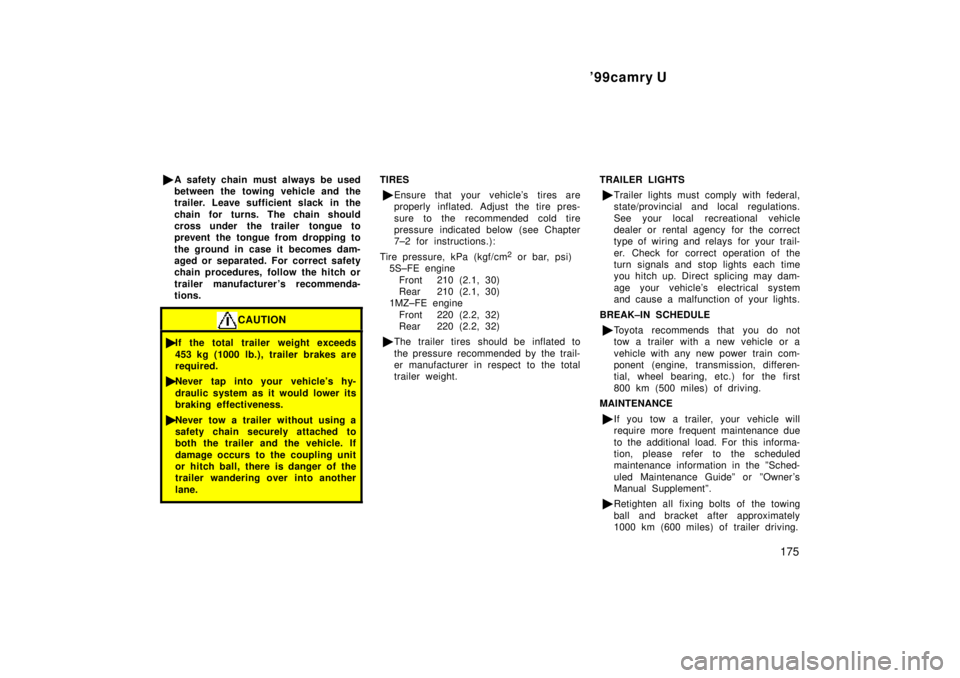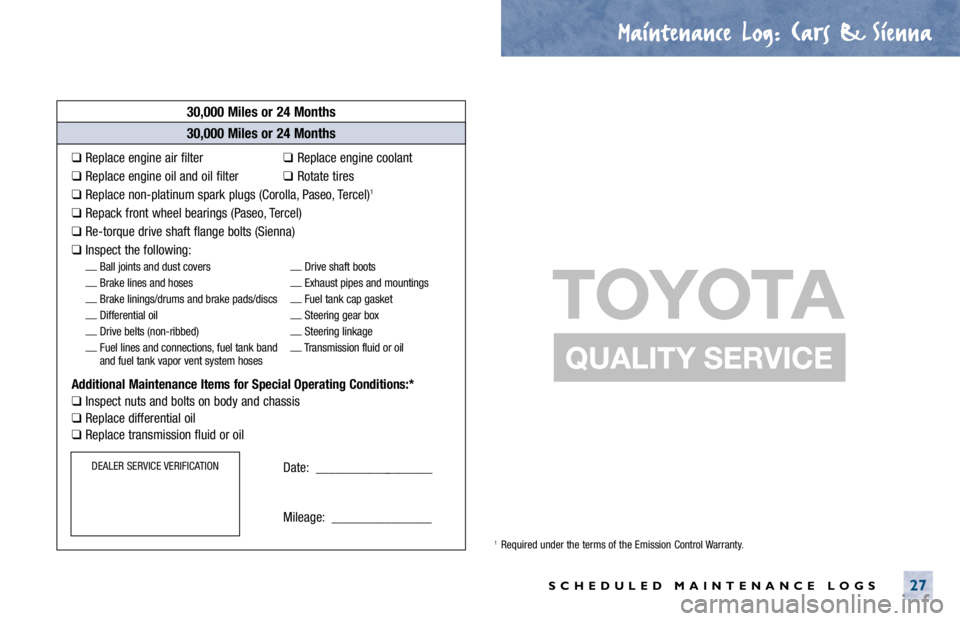Page 76 of 4770
TIMING BELT REMOVAL
(See Components for Removal and Installation)
1. DISCONNECT NEGATIVE (±) TERMINAL CABLE
FROM BATTERY
CAUTION: Work must be started after 90 seconds from
the time the ignition switch is turned to the 'LOCK'
position and the negative (±) terminal cable is discon±
nected from the battery.
2. REMOVE ENGINE COOLANT RESERVOIR TANK
(a) Disconnect the reservoir hose.
(b) While pushing the tab of the bracket, remove the
reservoir tank.
3. REMOVE GENERATOR (See page CH±10)
4. REMOVE RH FRONT WHEEL
5. REMOVE RH FENDER APRON SEAL
8. REMOVE ENGINE MOVING CONTROL ROD
Remove the 3 bolts and control rod.
9. DISCONNECT CONNECTOR FROM GROUND WIRE
ON RH FENDER APRON7. SLIGHTLY JACK UP ENGINE
Raise the engine enough to remove the weight from
the engine mounting on the right side. 6. REMOVE PS DRIVE BELT
Loosen the 2 bolts, and remove the drive belt.
± 5S±FE ENGINEENGINE MECHANICALEG1±26
Page 89 of 4770
19. INSTALL RH FENDER APRON SEAL
20. INSTALL RH FRONT WHEEL
21. INSTALL GENERATOR (See page CH±24)
Drive belt tension:
w/ A/C
New belt
175 + 5 lbf
Used belt
130 + 10 lbf
w/o A/C
New belt
125 + 25 lbf
Used belt
95 + 20 lbf
22. INSTALL ENGINE COOLANT RESERVOIR TANK
23. CONNECT NEGATIVE (±) TERMINAL CABLE TO
BATTERY 18. INSTALL AND ADJUST PS DRIVE BELT
Install the drive belt with the pivot and adjusting bolts.
Drive belt tension:
New belt
125 + 25 lbf
Used belt
80 + 20 I bf (b) Tighten the 3 bolts in the sequence shown.
Torque: 64 N±m (650 kgf±cm. 47 ft±lbf)
± 5S±FE ENGINEENGINE MECHANICALEG1±39
Page 143 of 4770
9. REMOVE TIMING BELT AND PULLEYS
10. REMOVE CYLINDER HEAD
11. REMOVE WATER PUMP AND GENERATOR
ADJUSTING BAR
12. REMOVE OIL PAN AND OIL PUMP
13. REMOVE OIL FILTER
14. w/ OIL COOLER:
REMOVE OIL COOLER 4. REMOVE REAR END PLATE
Remove the bolt and end plate.
5. INSTALL ENGINE TO ENGINE STAND FOR
DISASSEMBLY
6. REMOVE GENERATOR
7. REMOVE DISTRIBUTOR1. M/T:
REMOVE CLUTCH COVER AND DISC
2. M/T:
REMOVE FLYWHEEL
3. A/T:
REMOVE DRIVE PLATE
15. REMOVE KNOCK SENSOR
Using SST, remove the knock sensor.
SST 09816 ± 300108. REMOVE PS PUMP BRACKET
Remove the 3 bolts and PS pump bracket.
PREPARATION FOR DISASSEMBLY
± 5S±FE ENGINEENGINE MECHANICALEG1±93
Page 176 of 4770
13. M/T:
INSTALL FLYWHEEL
(a) Apply adhesive to 2 or 3 threads of the mounting bolt
end.
Adhesive:
Part No.08833±00070. THREE BOND 1324 or equi±
valent
14. A/T:
INSTALL DRIVE PLATE (See procedure step 13)
Torque: 83 N±m (850 kgf±cm, 61 ft±lbf)
15. M/T:
INSTALL CLUTCH DISC AND COVER(b) Install the flywheel on the crankshaft.
(c) install and uniformly tighten the mounting bolts in
several passes, in the sequence shown.
Torque: 88 N±m (900 kgf±cm, 66 ft±lbf)
± 5S±FE ENGINEENGINE MECHANICALEG1±126
Page 971 of 4770

'99camry U
175 �
A safety chain must always be used
between the towing vehicle and the
trailer. Leave sufficient slack in the
chain for turns. The chain should
cross under the trailer tongue to
prevent the tongue from dropping to
the ground in case it becomes dam-
aged or separated. For correct safety
chain procedures, follow the hitch or
trailer manufacturer 's recommenda-
tions.
CAUTION
�If the total trailer weight exceeds
453 kg (1000 lb.), trailer brakes are
required.
�Never tap into your vehicle's hy-
draulic system as it would lower its
braking effectiveness.
�Never tow a trailer without using a
safety chain securely attached to
both the trailer and the vehicle. If
damage occurs to the coupling unit
or hitch ball, there is danger of the
trailer wandering over into another
lane.
TIRES
�Ensure that your vehicle's tires are
properly inflated. Adjust the tire pres-
sure to the recommended cold tire
pressure indicated below (see Chapter
7±2 for instructions.):
Tire pressure, kPa (kgf/cm
2 or bar, psi)
5S±FE engine
Front 210 (2.1, 30)
Rear 210 (2.1, 30)
1MZ±FE engine
Front 220 (2.2, 32)
Rear 220 (2.2, 32)
�The trailer tires should be inflated to
the pressure recommended by the trail-
er manufacturer in respect to the total
trailer weight.TRAILER LIGHTS
�Trailer lights must comply with federal,
state/provincial and local regulations.
See your local recreational vehicle
dealer or rental agency for the correct
type of wiring and relays for your trail-
er. Check for correct operation of the
turn signals and stop lights each time
you hitch up. Direct splicing may dam-
age your vehicle's electrical system
and cause a malfunction of your lights.
BREAK±IN SCHEDULE
�Toyota recommends that you do not
tow a trailer with a new vehicle or a
vehicle with any new power train com-
ponent (engine, transmission, differen-
tial, wheel bearing, etc.) for the first
800 km (500 miles) of driving.
MAINTENANCE
�If you tow a trailer, your vehicle will
require more frequent maintenance due
to the additional load. For this informa-
tion, please refer to the scheduled
maintenance information in the ºSched-
uled Maintenance Guideº or ºOwner 's
Manual Supplementº.
�Retighten all fixing bolts of the towing
ball and bracket after approximately
1000 km (600 miles) of trailer driving.
Page 986 of 4770
'99camry U
190
CAUTION
Never get under the vehicle when the
vehicle is supported by the jack
alone.
ÐChanging wheels
7. Remove the wheel nuts and change
tires.
Lift the flat tire straight off and put it
aside.
Roll the spare wheel into position and
align the holes in the wheel with the bolts.
Then lift up the wheel and get at least the
top bolt started through its hole. Wiggle
the tire and press it back over the other
bolts.Before putting on wheels, remove any cor-
rosion on the mounting surfaces with a
wire brush or such. Installation of wheels
without good metal±to±metal contact at the
mounting surface can cause wheel nuts to
loosen and eventually cause a wheel to
come off while driving. Therefore after the
first 1600 km (1000 miles), check to see
that the wheel nuts are tight.
Page 1111 of 4770
SCHEDULED MAINTENANCE LOGS19 Towing a Trailer or Using a Camper
or Car-Top Carrier
•Inspect brake linings/drums and brake pads/discs
•Inspect nuts and bolts on chassis and body
•Replace differential oil
•Replace transmission fluid or oil
•Replace transfer oil *
•Lubricate propeller shaft and re- torque bolts*
Off-Road Maintenance
If you own a Land Cruiser or a four- wheel drive RAV4,
Tacoma or 4Runner, you should check the following items
daily whenever you drive off- road through deep sand, mud
or water:
•Brake lines and hoses
•Brake linings/drums and brake pads/discs
•Engine air filter
•Differential oil
•Steering linkage
•Transfer oil
•Transmission fluid or oil
•Wheel bearings
For all four- wheel drive vehicles except RAV4, you should
also lubricate the propeller shafts daily.
Determining Your Vehicle’s Maintenance Needs
Page 1119 of 4770

Maintenance Log.
. Cars & Sienna
SCHEDULED MAINTENANCE LOGS27
30,000 Miles or 24 Months
❑Replace engine air filter❑Replace engine coolant
❑Replace engine oil and oil filter❑Rotate tires
❑Replace non-platinum spark plugs (Corolla, Paseo, Tercel)1
❑Repack front wheel bearings (Paseo, Tercel)
❑Re-torque drive shaft flange bolts (Sienna)
❑Inspect the following:__
Ball joints and dust covers__
Drive shaft boots
__
Brake lines and hoses__
Exhaust pipes and mountings
__
Brake linings/drums and brake pads/discs__
Fuel tank cap gasket
__
Differential oil__
Steering gear box
__
Drive belts (non-ribbed)__
Steering linkage
__
Fuel lines and connections, fuel tank band__
Transmission fluid or oil
and fuel tank vapor vent system hoses
Additional Maintenance Items for Special Operating Conditions:*
❑Inspect nuts and bolts on body and chassis
❑Replace differential oil
❑Replace transmission fluid or oil
Date: __________________
Mileage: _______________
30,000 Miles or 24 Months
30,000 Miles or 24 Months
DEALER SERVICE VERIFICATION
1Required under the terms of the Emission Control Warranty.